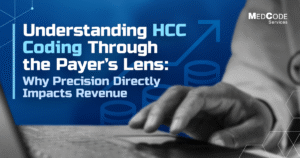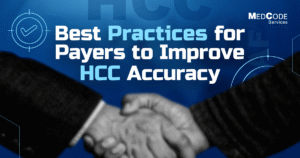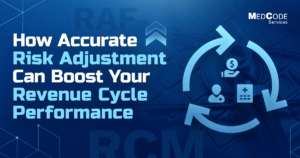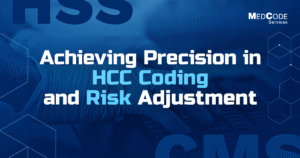In healthcare, knowing how complex a patient’s needs are isn’t optional; you miss that, and the consequences can be costly, both financially and clinically. Risk profiling is no longer just a box to tick; it directly influences how well financial goals and clinical responsibilities are met. Risk adjustment ensures health plans and providers are fairly compensated based on the health status and the expected care needs of their patient populations.
Hierarchical Condition Category (HCC) coding lies at the centre of this process, involving the assignment of diagnosis codes that reflect the severity of a patient’s health, thus forming a correct basis for risk score calculation. These scores guide how the major payers, such as Medicare Advantage and commercial insurers, adjust reimbursement to reflect the predicted care cost.
The accuracy of HCC coding shapes outcomes for everyone involved in the chain, from clinicians to payers and even policy-makers. While it means better alignment between the patient complexity and payment for providers, for payers, it allows more precise forecasting of the costs. And in the larger picture for the whole system, it supports the broader transition to value-based care, where the compensation is driven by outcomes, not volume.
Understanding Risk Adjustment & HCC Coding
Hierarchical Condition Category (HCC) coding serves as the structural base for risk adjustment models used across public as well as commercial healthcare programs. By grouping clinically related diagnoses into categories that reflect the severity of the disease, HCC coding enables payers to make a better estimate when it comes to future healthcare costs.
In practice, two models drive most of this work:
- CMS-HCC Model: Formulated by the Centers for Medicare & Medicaid Services, this model applies mainly to Medicare Advantage and focuses on older adults and people with qualifying disabilities.
- HHS-HCC Model: Developed by the Department of Health and Human Services, this model supports ACA marketplace plans and serves a broader, more diverse population.
Both assign each patient a Risk Adjustment Factor (RAF), a score tied to their expected healthcare costs. Higher scores point to a greater complexity, triggering higher reimbursements.
To ensure accuracy, several components must work in sync
- ICD-10-CM coding accuracy is vital, as it directly impacts RAF scores. All relevant diagnoses, chronic or acute, must be captured using the correct codes.
- Annual recapture of chronic conditions is necessary, even if a condition is stable, to correctly reflect care needs.
- Documentation must be clear, specific, and complete, forming the core for compliant coding.
- Coder expertise holds great significance. Risk adjustment coding requires familiarity with the key models, payer guidelines, and regulatory updates.
- Compliance with AHA Coding Clinic updates and CMS/HHS guidelines ensures correct code capture and reduces audit exposure.
Common Pitfalls in Risk Adjustment & HCC Coding
Even the most minute oversights in HCC coding can snowball into bigger problems than expected. Here’s where things go wrong:
- Incomplete or Missing Documentation: Gaps of any kind in documentation result in a diminished RAF score and reduced reimbursements.
- Under-Coding or Missed HCCs: Skipping valid conditions, even if they seem minor, can significantly understate patient complexity.
- Over-Coding or Unsupported HCCs: Assigning codes without clear documentation can draw compliance scrutiny and repayment demands.
- Inexperienced Coders: Coders unfamiliar with the specific rules and nuances of HCC coding may misinterpret documentation or overlook relevant diagnoses. It is crucial to provide consistent training to clinicians and also maintain clear communication.
- Outdated Knowledge of HCC Model Changes: Missing updates to CMS-HCC versions or payer rules can jeopardize compliance and accuracy.
- Compliance and Audit Risks: Improper coding affects payments and audit risks. Errors may lead to penalties or repayment demands if flagged during retrospective reviews.
- Revenue Impact: All these issues in totality create financial risk via reduced reimbursements.
MedCode’s Approach to Accurate Risk Adjustment Coding
Certified Coders With Deep Expertise
- MedCode has AAPC and AHIMA-certified coders with advanced training and expertise. They stay current with AHA Coding Clinic updates and follow ICD-10-CM guidelines to ensure compliant and complete code capture.
- Continuous mentoring and rigorous training programs keep them up to date with evolving models, payer guidelines, and documentation requirements.
Full-spectrum Services
- We support comprehensive, end-to-end services, including.
- Retrospective reviews for accurate capture of the patient’s history
- Concurrent coding for real-time compliance
- RADV audits and validation checks
- HEDIS abstraction (Hybrid and Supplemental)
- Retrospective reviews for accurate capture of the patient’s history
- Our team caters to a versatile client base, including hospitals, physician offices, IPAs, health plans, and other healthcare entities.
Agile and Scalable
- Our teams work round the clock and can scale quickly when client demand rises.
- Our teams’ extensive knowledge of various payer-specific models enables them to transition smoothly without stretching the onboarding periods.
- Our robust global delivery abilities help us effortlessly bridge the offshore gaps while ensuring cost-effectiveness and efficiency.
- Strong infrastructure and well-tested continuity plans keep our services running without any stress of interruption.
Compliance and Accuracy
- All operations are HIPAA-compliant and backed by SOC 2 and ISO 27001-certified infrastructure to ensure secure and compliant data handling.
- We maintain real-time dashboards and provide proactive reporting, along with dedicated team members who are there for personalized support.
- Our adherence to strict coding quality metrics helps reduce revenue loss while maximizing RAF scores.
- We follow a continuous improvement model, boosting operational efficiency and transparency at every stage.
How to Choose the Right Risk Adjustment Partner
Key factors to consider:
1. Expertise Backed by Practical Experience
While certifications like AAPC and AHIMA matter, real value comes from proven hands-on experience with CMS-HCC, HHS-HCC, and ICD-10 coding models. Practical experience ensures a stronger grasp of payer requirements and coding accuracy.
2. Infrastructure & Business Continuity
Look for HIPAA-compliant systems and ISO-certified processes with secure data exchange, redundancy mechanisms, and business continuity plans that maintain consistent service, even during disruptions.
3. Compliance Track Record
Choose partners like MedCode, who meet HIPAA, SOC 2, and ISO 27001 standards. These safeguards protect sensitive healthcare data and ensure full compliance with regulatory requirements.
4. Scalability and Flexibility
Your partner should adapt to shifting patient volumes and evolving risk adjustment models. Whether it’s RADV audits, HEDIS abstraction, or concurrent reviews, they must scale promptly without compromising accuracy or turnaround times.
5. Communication and Reporting
A credible partner offers proactive updates, transparent workflows, and regular audits. Clear visibility into performance and collaborative problem-solving improve efficiency and outcomes.
6. Market Insight
Choose a partner well-versed in payer-specific guidelines. This reduces onboarding time, minimizes errors, and cuts the extensive costs that go into the orientation processes.
Conclusion
When it comes to value-based care, accurate HCC coding isn’t just a strategic necessity; it’s a foundational pillar. Precise coding impacts every aspect of risk-adjusted care delivery, from improving RAF scores to ensuring compliance and optimizing reimbursements.
If you’re looking to strengthen your HCC coding framework, explore how MedCode Services can help you achieve your goals with expert-driven, scalable solutions designed for long-term impact.







